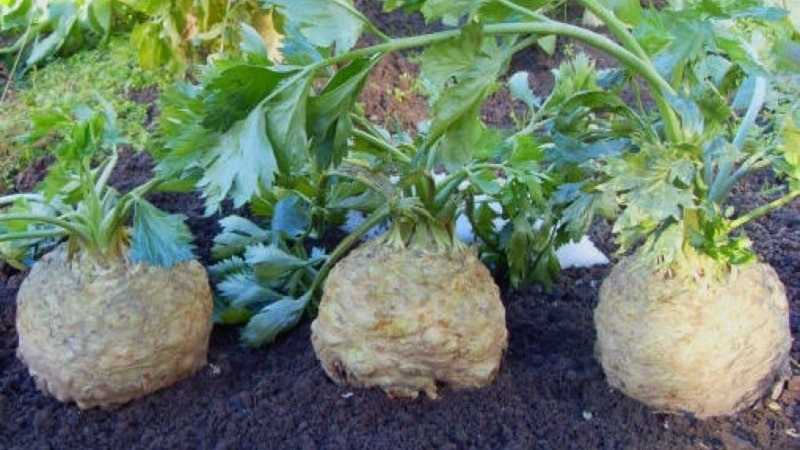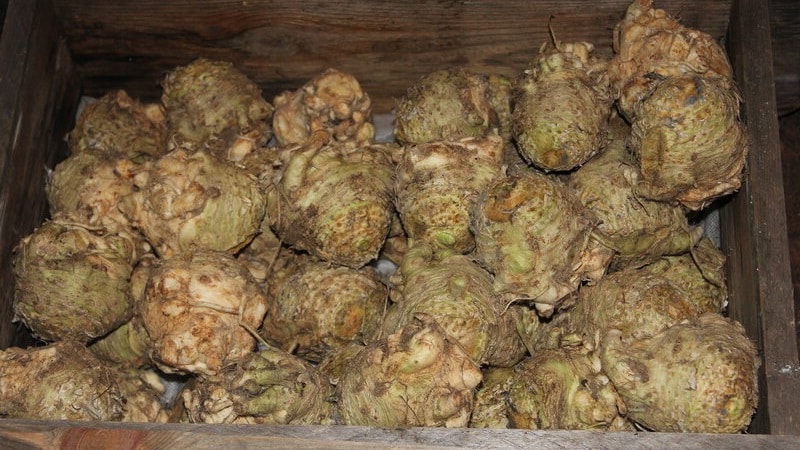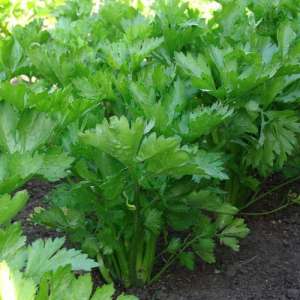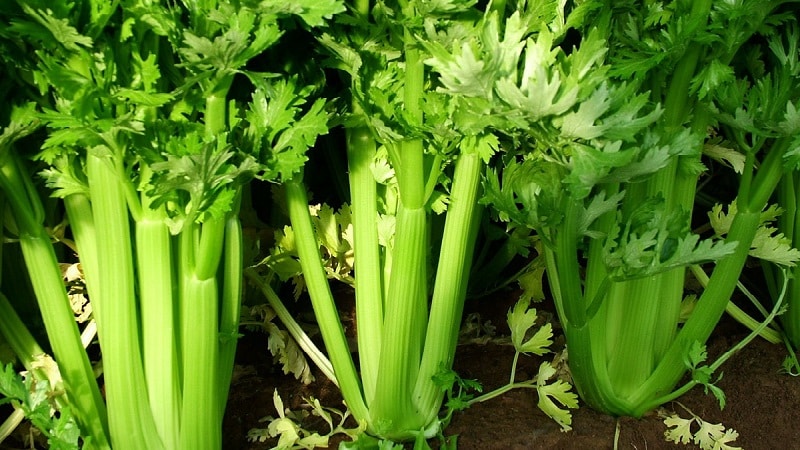How to properly dig up celery root and when to do it
Celery root is a tasty and healthy vegetable. But it’s not enough to grow a rich harvest of crunchy root vegetables - it’s important to harvest them correctly and in a timely manner so that your labors are not in vain. Let's consider when it is better to dig up celery root and how to do it correctly.
When is it time to dig up celery roots?
Root celery - a plant of short daylight hours with a long growing season (120–150 days). It is on cool autumn days that the vegetable begins to actively grow and accumulate nutrients. In hot summer weather the crop hardly grows.

Deadlines
It is important to harvest root crops in time in order to prepare them for transportation and storage. They must ripen well, otherwise they will be tasteless and quickly become unusable. Due to the delicate peel, the root crop is prone to withering and rotting.
The vegetable is resistant to cold and even slight frosts on the surface, so do not rush to harvest. It is usually harvested in the second half of October.
Late celery root varieties back in October and early November, they actively gain weight, taste, accumulate nutrients, and form a peel. At the same time, you should not delay the event until real frosts, since the taste of frozen vegetables changes greatly.
Advice! If the celery is caught in frost before harvesting, it is not immediately brought into a warm place, but left at a positive but low temperature, no higher than +10°C, so that it does not rot.
Experienced gardeners recommend harvesting celery after a good rain. If the weather is dry, the beds are watered. Then, when digging up root crops, it will be possible to avoid their damage, which will affect the keeping quality.
By what signs can you understand that it is ripe?
The color of the tops will help determine the degree of maturity of root crops. If it starts to turn yellow and dry out, it means the celery has stopped growing and it’s time to dig it up.
Ripening dates in different regions of Russia
The timing of ripening and harvesting of root crops largely depends on the weather conditions of areas located in different climatic zones of Russia, and the varietal characteristics of the crop. It is important to plant a plant that will have time to ripen and yield a harvest. can be stored for a long time.

When to harvest celery in different regions of Russia:
- The Moscow region is characterized by clearly defined seasonality, high humidity, warm summers, moderately cold winters with stable snow cover and thaw. For these places, mid-early varieties of the crop are chosen, the ripening period of which is 140–150 days. Harvest occurs at the beginning of October.
- The Volga region is characterized by frosts in early spring and late autumn, snowy winters and hot summers, so it is better to plant early and medium varieties here. Cleaning time celery in this region - September - October.
- For northern regions (Urals and Siberia) with a cold climate and frosty winters, early varieties are chosen for planting, and the harvest is harvested before mid-September.
- In the Krasnodar and Stavropol territories, where the southern warm climate, varieties are grown late ripening period (about 200 days). Root crops are dug up at the end of October.
How to dig up celery root correctly
To avoid damaging the root crops when digging, it is better to use a fork or a flat shovel.
Attention! Simple pulling out is suitable only in case of quick use of vegetables: with this method of harvesting, the root vegetables are severely damaged, which reduces their shelf life.
When digging vegetables, it is advisable to grab a large volume of soil around, then the root system will remain intact. To do this, they retreat 10–15 cm from the root crop, dig it up and, grasping the tops, carefully remove it from the ground with their hands.
After harvesting, the root crops are sorted and their quality is checked: they must be hard, without damage or rot, small healed cracks are acceptable.
Before being sent for storage, the crop is prepared:
- Clean or shake off the soil.
- Wash in water and leave in the sun for 1-2 hours to dry.
- The entire green part is cut off at a distance of 2 cm from the base and left on the bed as fertilizer. When cutting tops, it is important not to damage the growing point.
- To prevent the cut areas from drying out and starting to rot, the vegetables are laid out in a shaded, ventilated room.
- Store in the basement, refrigerator or freezer.
Root vegetables with slight mechanical damage are not suitable for long-term storage - it is better to use them immediately.
Harvest storage

To keep celery fresh longer, create the following conditions:
- low temperature - 0...+4°C;
- optimal humidity is 80–90%.
Under such conditions, fresh vegetables are stored for 2 to 4 months (in a pit, cellar or basement).
There are many ways to extend the shelf life of a crop:
- In the apartment. In room conditions, the shelf life of celery is minimal - no more than 4 days.To prolong them, choose the coolest and darkest place (for example, a pantry) or place the vegetables in a box mixed with damp sand, cover with cling film and place under the window in the kitchen. The film is periodically removed to prevent vegetables from rotting due to lack of oxygen.
- In the country. They dig a hole, put root vegetables in it in one layer, sprinkle with sand and earth. The method is only suitable for areas with mild climates where the soil does not freeze in winter.
- In a basement, barn or cellar. Vegetables are placed in wooden boxes, covered with sand and lime, covered with sand and covered with clay. When it dries, the boxes are placed on racks and shelves.
- In a refrigerator. Celery is washed under running water, dried and packaged in plastic bags with holes for ventilation. Place in the vegetable compartment and keep at a temperature of +3...+6°C. This will keep the crop fresh and juicy for 10-30 days.
- In the freezer. To freeze vegetables, they are processed, cut into pieces and placed in a bag. Keep for up to 1 year.
Harvesting and storing leaf celery

Not only celery roots are used for food, but also other parts: long green petioles and upper leaves. The vegetable is rich in vitamins C, group B, carotene, organic acids, minerals and flavonoids. Therefore, it is important to preserve the value of the plant during harvesting.
Thus, it is recommended to harvest leaf celery before frost, since the leaves wither in the cold, losing all their beneficial substances. They are cut 2-3 times during the summer with an interval of 35–40 days. The maximum time for collecting leaves is late September - early October.
Important! Leaves must not be picked. They are cut with a sharp knife, leaving petioles at least 5 cm long.This will preserve the central rosette, which will grow again, and protect the root system from rotting in winter.
Cut leaves wither very quickly, so they are immediately washed, dried and stored:
- Clean leaves are wrapped in aluminum film and placed in the refrigerator. In this form, the preparation is good for 7–10 days. It is better not to use polyethylene, as after 3 days the greens will lose their color, taste and benefits.
- The greens are laid out on a white paper sheet and covered with the same on top. Over the course of a month, the celery is dried and then used as a seasoning.
- The leaves are crushed, placed in a plastic container and frozen.
- The greens are chopped and sprinkled with salt (100 g per 0.5 kg of leaves). Place in glass jars and seal.
Chereshkova

The petioles of the plant are cut several times during the growing season, when the length of the leaves reaches approximately 30 cm. The most suitable time for the last harvest is the end of September and the very beginning of October. A correctly chosen period allows you to preserve the unique taste of greens. The harvest is prepared for the winter.
Important! The main sign that the petioles are ripe is the appearance of white color and the disappearance of the spicy, pungent taste.
Bleaching is carried out before harvesting. It removes the bitter taste from the petioles and makes them more tender. For this:
- A few weeks before harvesting, the petioles are tied into a bundle.
- The lower part is wrapped in burlap or other breathable material.
- Before cleaning, remove the fabric.
Celery with yellow stalks does not need this procedure, as it is much more tender than other varieties.
How to store petioles:
- In the basement. During harvesting, celery is dug up along with the root so as not to damage it.The plants are wrapped in cloth and left there until they are sent to the basement, where boxes of wet sand are placed. When everything is prepared, the vegetables are placed in the sand. When storing in this manner, it is important to ensure good ventilation.
- In a refrigerator. Leaves and roots are removed from the petioles, washed well and left to dry. Dried plants are wrapped in cling film or foil and placed in the refrigerator.
- In the bank. The roots of the plants are cut off and placed in a jar filled with tap water. They leave it in the kitchen like this.
Celery will last about 7 days in a jar without refrigeration. Be sure to change the water daily and trim the stems a little.
Advice from experienced summer residents
To get a good harvest, be sure to treat the crop with compounds that protect against slugs (for example, “Thunderstorm”, “Slug Eater”).
To protect celery, the foliage is wrapped in paper or foil. This is especially useful when the plant is very lush. Thanks to the wrapping, the bushes will grow vertically without falling apart or bending towards the ground.
After any feeding, vegetables are doused with water from a watering can or hose. There should be no fertilizer left on top of the leaves.
Conclusion
Celery is a tasty and healthy crop, so it is important to preserve the harvest for as long as possible. To do this, select the correct cleaning time depending on the region and weather conditions. For long-term storage for the winter, it is better to roll up vegetables in jars or transplant them into the basement, into damp sand.